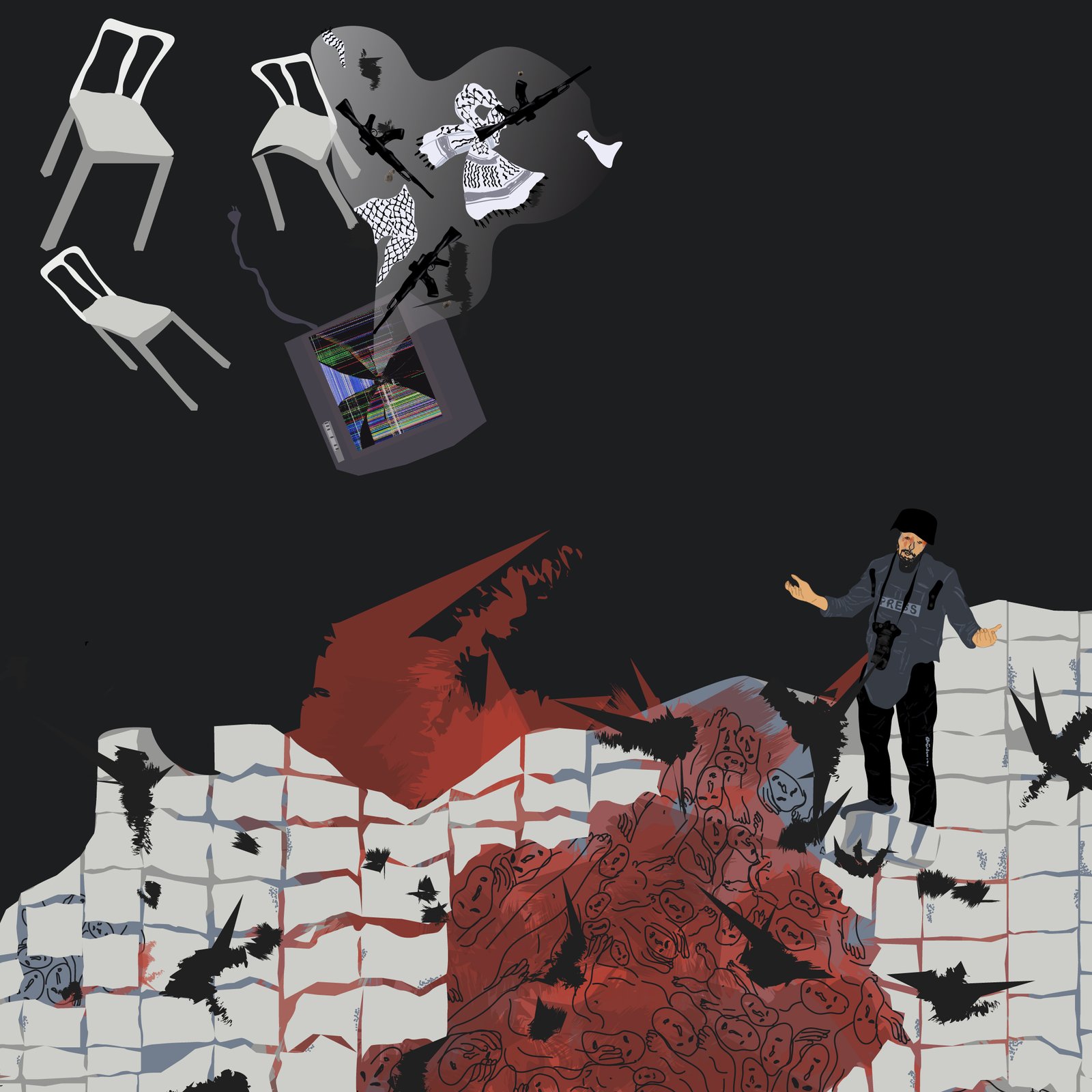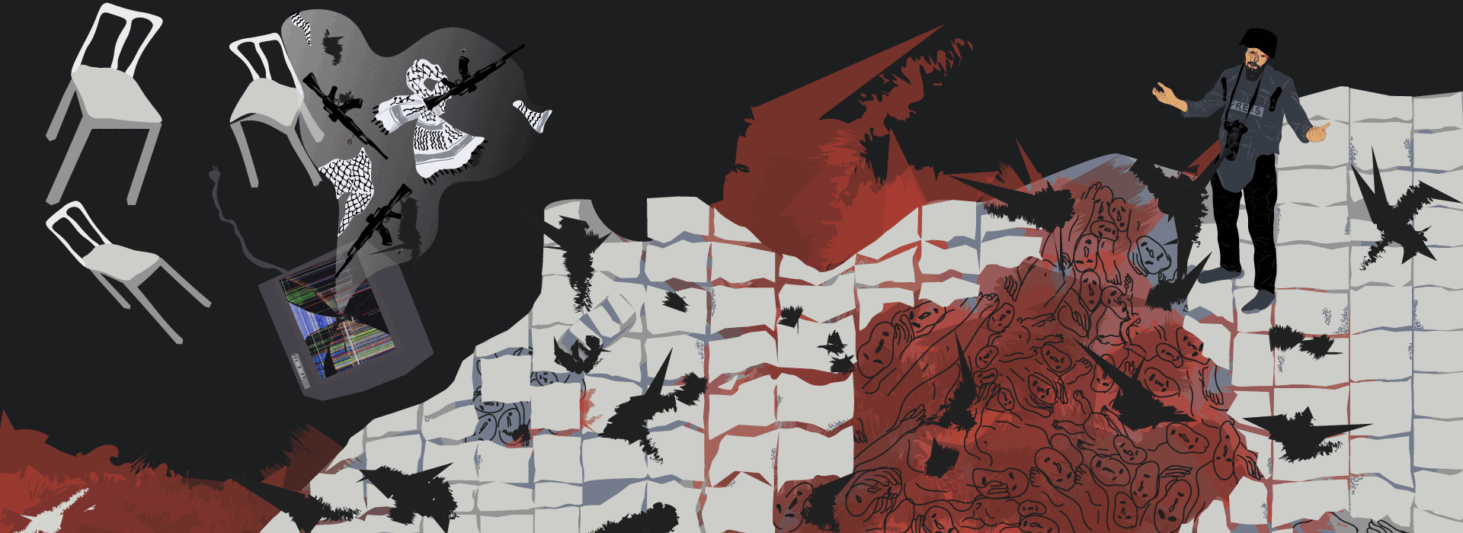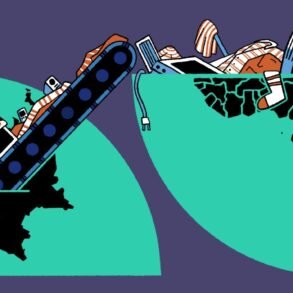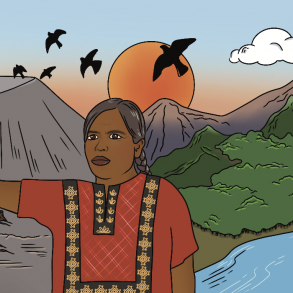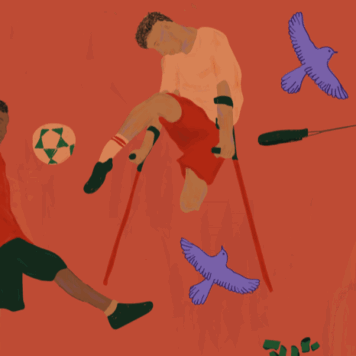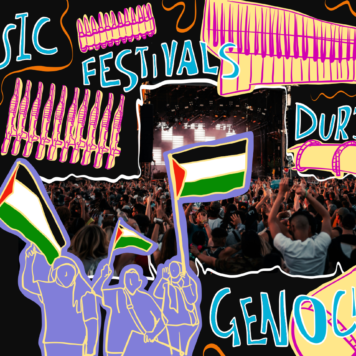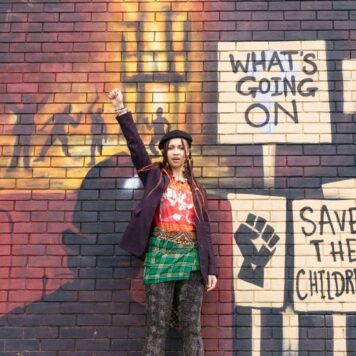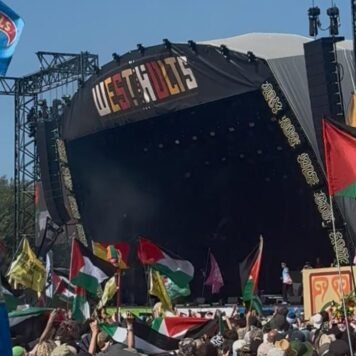7th October was a defining moment for my – and most Palestinians’ – relationship with traditional and non-traditional media. In hindsight, this reignition of the propaganda war shouldn’t have come as a surprise to any of us.
However, the distinct fervour in which the West lies and defends Israel really disarmed me. While the Palestinian population in Gaza and the West Bank continue to be subjected to what can only be described as systemic genocide, in the diaspora we have not been allowed to fully consider the extent of human life lost, and horrific dehumanisation of Palestinians when confronted by the rhetoric being spread by western news outlets.
Following 7th October, I saw how any interpretation that did not prescribe to the mainstream perspective of ‘terrorist’ versus ‘innocent’ was at best instantly demonised; at worst, it was criminalised. Anything short of full fledged condemnation, even an acknowledgement of the context that led to the events that took place, was met with hostility and branded as anti-semitic or terrorist sympathising.
All over Germany, protests supporting Gaza were banned, and met with mass arrests and brutality from the police. The (since axed) UK home secretary Suella Braverman encouraged the Met police to broaden the definition of support for terrorism, to include the “waving of a Palestinian flag”, and the common chant of “from the river to the sea”. The media took this precedent and ran with it, creating an even more hostile environment through their misinformation. Both on an official level, and a civil level, support for Palestine and Gaza became a taboo.
The media and its cycles
Herein began a cycle, where western media programmes published disputed claims from an inherently, if sometimes thinly veiled, Zionist perspective with no care for substantiation, and subsequently (but often too late) redacted their lies and misinformation.
One example was the allegation of rape in the Los Angeles Times, which was later redacted in a footnote stating that “such reports have not been substantiated.” The most significant and widespread of the lies that I have found has been the reports of ’40 beheaded infants’ which was broadcasted and then not substantiated nor confirmed neither by the Israeli government, nor President Biden, nor media platforms such as CNN.
In fact, CNN presenter Sara Sidner herself tweeted an apology in which she reaffirmed that she could not confirm the allegation. Similarly, President Biden’s spokesperson confirmed that he himself had not actually seen proof as he had previously claimed, but rather “based his comments about the alleged atrocities on the claims from Netanyahu’s spokesman and media reports from Israel.”
This media activity is as deliberate as it is deceptive. At the very heart of it lies a clear objective to shift the conversation: redirecting our attention, diverting our gaze, and dampening outrage by insisting on confusion through misinformation.
In the last month, I’ve found myself spending more time fighting a propaganda machine than grieving the loss of my people in Gaza, because western media continues creating crises of their own, using misinformation to create hype that rivals the attention on the genocide being perpetrated by Israel.
For the western media, it’s a game. You see blatant lies being published on traditional media, only to later see the debunking of said lies from analysts on social media, and then an expected redaction. This is even assuming that they will have enough of a conscience to redact, but this is only the best case scenario, the reality is that a lot of these platforms would rather feign ignorance than accept any culpability. So, finally, the mainstream narrative becomes saturated by a conversation about lies rather than lives, and in turn we lose the focus of the conversation.
In each of these cases, the reach of the redaction does not match the original claim. The damage has already been done to a fatal degree, and Palestinians are left to deal with the repercussions – whether it is in the line of active fire, or in our streets, workplaces, and universities in the diaspora.
The most harrowing example of false narratives on Palestinians in the diaspora is the killing of Wadea Al-Fayoume, who was stabbed 26 times by his landlord in a racist, Islamophobic attack. The landlord’s radicalisation can widely be attributed to the western media’s coverage of what has taken place since 7th October, specifically on conservative radio coverage.
The best way I can explain it is that misinformation stains. Once it leaks out in the world, it has already to some extent corrupted the narrative, and no amount of ‘clean-up’ through apology, acknowledgement of wrongdoing or redaction, can get rid of the stain that it has left on their consumers.
The weaponisation of language
In the face of such blatant lies, and the fabrication of information, it is clear there has been an intentional grooming of the western consumer to only feel outrage when the media permits it.
I became fully aware of this, having already seen its life-threatening implications, in the aftermath of the Israeli bombing of the Baptist hospital. CNN, yet again, pedalled a harmful narrative, this time: ‘Gaza hospital blast shrouded in uncertainty’.
This headline was published despite multiple media outlets and transnational organisations presenting substantial evidence that the attack was conducted by the Israeli military. This includes evidence from Channel 4 analysts and even the World Health Organisation, who revealed that the hospital had been warned to evacuate as early as 14th October.
Clear as day the standard has been set. In times of Israeli adversity, factual evidence is optional, the media moves to make assertive claims against Hamas with no ambiguity. Palestinians, on the other hand, undergo rigorous investigation, only to have their tragedy reported on with passive language with no clear perpetrator, demonised even in death. This profound and blatant disregard of fairness has left me, my Palestinian friends and family, and all those who support us, truly dumbfounded as to the extent of its cruelty.
The conclusion begs to be drawn that ambiguity in the reporting of events highlights the Zionist necessity for historical revisionism to maintain a façade of innocence in the wake of the atrocities it commits.
It comes in the form of the weaponisation of language, while a Palestinian ‘dies’, an Israeli is ‘killed’; and a violent western-backed genocide against an overwhelmingly civilian population becomes a conflict. It then further manifests in the media cycles which it perpetuates.
It operates step-by-step. It begins with initial denial of the atrocities the state itself has committed. Then ensue perplexing mental gymnastics that ultimately result in blaming Palestinians – a narrative which the western media pushes. Finally, months, years, or decades later, comes an admission that the Israeli regime was, indeed, at fault. This is publicised, but once again with minimal reach.
Subscribe to shado's weekly newsletter
Exclusive event news, job and creative opportunities, first access to tickets and – just in case you missed them – our picks of the week, from inside shado and out.

A recent example of this was in the horrific killing of Palestinian journalist Shireen Abu Akleh, who was shot dead by an Israeli sniper despite wearing a clearly marked ‘press’ vest. After initially blaming Palestinian fighters, Israel admitted fault four months after her death. In the case of Shireen, and the case of the Baptist Hospital, any admission of guilt often comes too late, violently obscuring a reality that Palestinians know all too well: that Israel always have and always will be able to continue to perpetrate the most brutal of atrocities with little to no repercussions with the immunity of a western propaganda machine.
Social media as a solution, the Instafada
With this historical revisionism, Palestinians have had to come up with creative ways to ensure the truth is heard: enter the Instafada.
The rise of social media has been invaluable to the spread of the Palestinian cause, and in the education of the genocide occurring. Mohamed El Kurd started off posting on social media about the struggles of his family in the neighbourhood of Al-Sheikh Jarrah in Jerusalem during 2021, and co-founded the #saveSheikhJarrah movement.
This was a turning point in how I approached my activism for Palestine. I was met with much more sympathy then, I think because, rather than using statistics and numbers as I had been previously, I began arguing from a much more human basis. The reality of our situation began to be revealed through the spread of videos, images, and testimony coming straight from the ground.
The vital difference between its spread on traditional media versus social media, is inherently this directly human aspect. Social media provides peoples across the West with a direct line of communication to the Palestinian street that is unfiltered, uncensored, and indisputable. This has allowed Palestinians to reclaim their humanity in the face of the dehumanisation of traditional media.
Alongside the debunking of false claims on X, Instagram and TikTok among other social media platforms, people on the ground have been using social media to report on the ongoing humanitarian crisis.
In current days, journalists in Gaza – recognising the failures of western media in accurately presenting their struggle for justice – have begun to publish direct footage on Instagram and X. Despite heavy shadow-banning and censoring, journalists such as Motaz Azaiza (@motaz_azaiza) and political accounts such as Eye On Palestine (@eyeonpalestine) post daily, showing the reality of the genocide occurring in Gaza.
In adding this human aspect to the reports on the active murder of Gazans, social media allows Palestinians to circumvent the western media which has either facilitated space for their dehumanisation or completely erased them. In recognising the failure of our traditional media to elevate these voices, we should begin to give social media the same importance that we give established media institutions in the Palestinian context.
When the media we consume comes straight from the people being impacted, and not through channels which weaponise ‘objectivity’ to spread a certain agenda, it becomes much clearer to whom we owe our allyship. The average western consumer will not view a Palestinian as a human until they see themself in them, this isn’t a criticism but an observation on how this is how traditional forms of media have groomed us.
In the Palestinian case, this has been 75 years in the making, with the Western media taking liberty in how they portray the humanity of the Palestinian as a concept, and their subsequent denial of our humanity to permit oversight in their reporting on what has been unfolding for the past month.
Social media has allowed the Palestinian cause to replicate this to a mind-blowing degree, with repercussions that have had a hand in igniting a digital revolution and a reconsideration of the role of traditional media in our day-to-day, and to what extent we can truly trust it.
Indeed, we have raised our own global “Instafada”, which has given the Palestinian a human face that cannot be confiscated when it does not suit the set agenda.
What can you do?
Follow:
- Motaz Azaiza (@motaz_azaiza) Gazan photojournalist, film maker, photographer
- Plestia Alawad (@byplestia) Independent journalist
- Hind Khoudary (@Hindkhoudary) Journalist based in Gaza
Listen:
- What’s unsaid: The media’s silencing of Palestinians – The New Humanitarian
Read:
- ‘The Wrong Story’ by Greg Shupak
- ‘Language and propaganda: Challenges to Media Interpretations of the Palestine question’ Adel Safty, Arab Studies Quarterly, Vol. 13.
- ‘How media coverage whitewashes Israeli state violence against Palestinians’ Washington Post, by Laura Albast and Cat Knarr
- ‘Get this straight, Western media: Palestinians aren’t subhuman’ Al Jazeera, by Andrew Mitrovica
- What is Israeli Apartheid?
- There is nothing complicated about the situation in Palestine
- What is Zionism?
